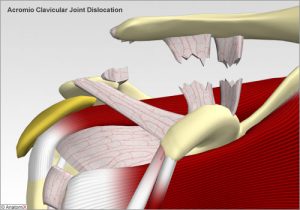A separated shoulder, also known as Acromioclavicular Joint Dislocation, is a common injury to the acromioclavicular joint. The AC joint is located at the outer end of the clavicle where it attaches to the acromion of the scapula. Symptoms include pain which may make it difficult to move the shoulder and often a deformity.
It is most commonly due to a fall onto the front and upper part of the shoulder when the arm is by the side. They are classified as type I, II, III, IV, V, or VI with the higher the number the more severe the injury. Diagnosis is typically based on physical examination and X-rays.
In type I and II injuries there is minimal deformity while in a type III injury the deformity resolves upon lifting the arm upwards. In type IV, V, and VI the deformity does not resolve with lifting the arm.
Generally types I and II are treated without surgery, while type III may be treated with or without surgery, and types IV, V, and VI are treated with surgery. For type I and II treatment is usually with a sling and pain medications for a week or two. In type III injuries surgery is generally only done if symptoms remain following treatment without surgery.
A separated shoulder is a common injury among those involved in sports, especially contact sports. It makes up about half of shoulder injuries among those who play hockey, football, and rugby. Those affected are typically 20 to 30 years old


